Kashechewan calamity .. Gomery watch interrupted way up north
Oct 31st, 2005 | By Randall White | Category: Canadian Provinces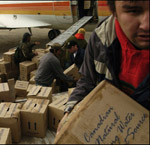 How many of what the 2001 Census called the 20 fastest-growing “census subdivisions” in Canada’s most populous province of Ontario can you name? If you guess the City of Vaughan, just north of Toronto, you are not doing too badly. That was number 20. If you go on to guess the Town of Wasaga Beach on Georgian Bay, you deserve a small prize. That was number 16. Yet only the keenest students will make much progress from here.
How many of what the 2001 Census called the 20 fastest-growing “census subdivisions” in Canada’s most populous province of Ontario can you name? If you guess the City of Vaughan, just north of Toronto, you are not doing too badly. That was number 20. If you go on to guess the Town of Wasaga Beach on Georgian Bay, you deserve a small prize. That was number 16. Yet only the keenest students will make much progress from here.
In fact, every single one of Ontario’s 18 other 20 fastest-growing places in the 2001 Census was an Indian or First Nations reserve, further north again. You can qualify these blunt statistics in various ways. But they help explain why Globe and Mail columnist Jeffrey Simpson has called the ongoing evacuations from Kashechewan, Ontario, on the shores of James Bay, “a message from the black hole of the nation’s consciousness.” This scandal is not like the one Justice Gomery will be telling us about on November 1. But in the end it may deserve just as much attention.
A quick closer look at the census data …
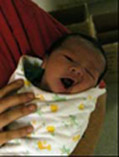 As someone on the Wikipedia Free Encyclopedia website aptly enough explains, “Indian reserve” is in the first place a somewhat arcane legal term in the most northern part of North America today. “Superficially a reserve is similar to an American Indian reservation,” but “reserve is normally the standard term in Canada.” Among many other things, the “terms First Nations reserve and First Nation are also widely used instead of Indian reserve; confusingly, First Nation also designates a group which may occupy more than one reserve.”
As someone on the Wikipedia Free Encyclopedia website aptly enough explains, “Indian reserve” is in the first place a somewhat arcane legal term in the most northern part of North America today. “Superficially a reserve is similar to an American Indian reservation,” but “reserve is normally the standard term in Canada.” Among many other things, the “terms First Nations reserve and First Nation are also widely used instead of Indian reserve; confusingly, First Nation also designates a group which may occupy more than one reserve.”
Kashechewan, at the mouth of the Albany River on James Bay, qualifies under yet another variation on the last of these points. According to a 1999 local report, it is “a First Nation of the Albany Reserve #67.” (And its 1999 population was 1,561.)
Statistics Canada has further confused the general picture by using the term Indian Reserve (“R”) to designate one of the types of what it calls “Census subdivisions” (which also involve municipalities such as cities, towns, villages, and townships). Wikipedia notes that, in the legal sense presided over by the federal Department of Indian and Northern Affairs in Ottawa, there are “over 600 occupied reserves in Canada, most of them quite small in area.” (The Thunder Bay Chronicle Journal has recently reported the exact number as 633.) But as Statistics Canada uses the term, there are 1,052 “Indian Reserves” in Canada, 145 of which are in Ontario. (BC has 487, and Saskatchewan 169. All the other provinces have less.)
As a sign of just how black Jeffrey Simpson’s “black hole of the nation’s consciousness” is, the name Kashechewan, Ontario does not appear at all in the Statistics Canada classification. Here the community is one of two “Indian Reserves” designated “Fort Albany (Part) 67.” In 2001 data for this community was subject to “suppression criteria.” The 2001 Census, that is, cannot tell us just what kind of population growth took place in Kashechewan between 1996 and 2001. (The Census actually appears to report Kashechewan’s 2001 population as 0 – which seems quite strange, considering that it had 1,561 people in 1999, and that 2005 estimates reported in the media have run as high as 1,900.)
20 FASTEST GROWING ONTARIO CENSUS SUBDIVISIONS, 1996-2001
|
Name |
Type |
Pop 2001 |
Pop 1996 |
% Change |
|
Canada |
30,007,094 |
28,846,761 |
4.0 |
|
|
Ontario |
11,410,046 |
10,753,573 |
6.1 |
|
|
Big Island Mainland 93 |
R |
85 |
9 |
844.4 |
|
The Dalles 38C |
R |
118 |
34 |
247.1 |
|
Northwest Angle 33B |
R |
97 |
35 |
177.1 |
|
Pic Mobert North |
R |
167 |
67 |
149.3 |
|
Wahnapitei 11 |
R |
49 |
26 |
88.5 |
|
Gull River 55 |
R |
252 |
159 |
58.5 |
|
Wapekeka 2 |
R |
329 |
209 |
57.4 |
|
Cat Lake 63C |
R |
428 |
275 |
55.6 |
|
Chapleau 75 |
R |
93 |
60 |
55.0 |
|
New Post 69A |
R |
105 |
71 |
47.9 |
|
Sabaskong Bay 35D |
R |
346 |
234 |
47.9 |
|
Wawakapewin |
R |
31 |
21 |
47.6 |
|
North Spirit Lake |
R |
231 |
157 |
47.1 |
|
Weagamow Lake |
R |
697 |
475 |
46.7 |
|
Sachigo Lake 1 |
R |
443 |
305 |
45.2 |
|
Wasaga Beach |
T |
12,419 |
8,698 |
42.8 |
|
Kasabonika Lake |
R |
740 |
520 |
42.3 |
|
Abitibi 70 |
R |
127 |
92 |
38.0 |
|
Chapleau 74A |
R |
33 |
24 |
37.5 |
|
Vaughan |
C |
231,549 |
182,022 |
37.3 |
TYPE CODE: R=Reserve; T=Town; C=City. SOURCE: Statistics Canada.
Even setting all the particular mysteries about Kashechewan aside, the 18 fastest-growing Ontario census subdivisions that were Indian Reserves between 1996 and 2001 all had very small populations. (Kashechewan itself is unusually large in this respect.) “Fastest-growing” places, in terms of raw percentage population increases, is a rough and ready concept at best. More than two dozen Ontario Indian reserves actually lost population between 1996 and 2001, according to Statistics Canada. And various other such qualifications could be advanced, on and on.
Yet looking at the top 20 Ontario places in terms of raw percentage population increases between 1996 and 2001 does dramatize a few more general characteristics of what Pierre Trudeau’s Constitution Act 1982 calls “the aboriginal peoples of Canada” today. As the last Census also reported, for the country at large: “In 2001, a total of 976,305 persons identified themselves” as “an Aboriginal person, that is, as a North American Indian, Mtis or Inuit. … This count was 22.2% higher than the 1996 figure of 799,010. In contrast, the non-Aboriginal population grew only 3.4% between 1996 and 2001.”
A quick closer look at Kashechewan …
 As the 2001 Census reported as well, in Canada at large between 1996 and 2001 “the proportion of Aboriginal people who lived on Indian reserves and settlements declined from 33% to 31%.” Close to a majority of the country’s aboriginal peoples today live in urban areas – and especially in “Winnipeg … Edmonton, Vancouver, Calgary, Toronto, Saskatoon, Regina …Ottawa-Gatineau … Montral and Victoria.”
As the 2001 Census reported as well, in Canada at large between 1996 and 2001 “the proportion of Aboriginal people who lived on Indian reserves and settlements declined from 33% to 31%.” Close to a majority of the country’s aboriginal peoples today live in urban areas – and especially in “Winnipeg … Edmonton, Vancouver, Calgary, Toronto, Saskatoon, Regina …Ottawa-Gatineau … Montral and Victoria.”
Indian reserves and settlements like Kashechewan nonetheless do remain the key centres of human life for just under a third of the aboriginal peoples of Canada. And their at best often troubled conditions dramatize the larger problems of both aboriginal peoples, and current Canadian aboriginal public policy – as practised by all of federal, provincial, and territorial governments, and an increasingly developed contemporary aboriginal political leadership. (Probably the single best quick overview of “First Nations Communities” down on the ground in present-day Ontario, by the way, is a map on the Chiefs of Ontario website.)
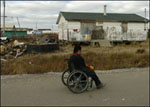 The exact scandalous problem which has finally thrust Kashechewan onto the bigger stage of Canadian federal politics, just before the release of the first Gomery report on the sponsorship scandal, is a contaminated local water system. It is so bad that it has finally forced substantial evacuations from the community for medical reasons. Kashechewan also has a recurrent miniature-New Orleans-problem of being located on flood plains, where a big river empties into salt water. (The federal government in Ottawa has now finally said it will gradually move the settlement to higher ground up the Albany River. Meanwhile, it has also now finally sent Canadian military technicians up to James Bay to fix the local water system.)
The exact scandalous problem which has finally thrust Kashechewan onto the bigger stage of Canadian federal politics, just before the release of the first Gomery report on the sponsorship scandal, is a contaminated local water system. It is so bad that it has finally forced substantial evacuations from the community for medical reasons. Kashechewan also has a recurrent miniature-New Orleans-problem of being located on flood plains, where a big river empties into salt water. (The federal government in Ottawa has now finally said it will gradually move the settlement to higher ground up the Albany River. Meanwhile, it has also now finally sent Canadian military technicians up to James Bay to fix the local water system.)
According to a Canadian Press story run last week in the Thunder Bay Chronicle Journal: “Kashechewan is a place of peeling paint and smashed windows, of children with chronic skin rashes who play on filthy mattresses, and of a water supply that’s so filthy, it has already made half of its residents sick.” As true as all this no doubt is, various Internet websites also offer hints about the community’s continuing humanity – and even a few small attractions, of various sorts.
 Kashechewan, e.g., apparently has one church, one restaurant, and two community groups. It also has a “Youth Patrol,” whose 11 male members reported this past March that: “We have been doing this for a little over 5 years now. Our duty as the Youth Patrol of Kashechewan Ontario is to ensure the safety of the community members. Our job is simple but can be dangerous and emotional at times but we are obligated to do our duty.”
Kashechewan, e.g., apparently has one church, one restaurant, and two community groups. It also has a “Youth Patrol,” whose 11 male members reported this past March that: “We have been doing this for a little over 5 years now. Our duty as the Youth Patrol of Kashechewan Ontario is to ensure the safety of the community members. Our job is simple but can be dangerous and emotional at times but we are obligated to do our duty.”
There is as well a “winter road that runs from Moosonee to Fort Albany, Kashechewan and Attawapiskat,” along the sub-polar James Bay coast. The “trip takes about three hours each way to Kashechewan … Many people from the coastal communities use the road to come to Moosonee to shop for groceries and supplies.”
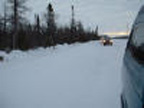 A DeBeers Canada diamond mining start-up is active in the wider region. This past February it reported that “a small group of residents from the Kashechewan First Nation re-instated a blockade on the winter road between Moosonee and Attawapiskat … In meetings with De Beers … it has become apparent that individuals from Kashechewan are now using this blockade to secure additional financial compensation from the company for the portion of the winter road that crosses their reserve lands.” DeBeers has also stressed that its “Victor Project” in the region “has employed over 170 people from Attawapiskat, Kashechewan, Fort Albany, Moose Factory and Moosonee coastal communities since 1999 … When the project proceeds to construction … up to 600 people will be employed and 380 people during production.”
A DeBeers Canada diamond mining start-up is active in the wider region. This past February it reported that “a small group of residents from the Kashechewan First Nation re-instated a blockade on the winter road between Moosonee and Attawapiskat … In meetings with De Beers … it has become apparent that individuals from Kashechewan are now using this blockade to secure additional financial compensation from the company for the portion of the winter road that crosses their reserve lands.” DeBeers has also stressed that its “Victor Project” in the region “has employed over 170 people from Attawapiskat, Kashechewan, Fort Albany, Moose Factory and Moosonee coastal communities since 1999 … When the project proceeds to construction … up to 600 people will be employed and 380 people during production.”
Two adventurous young ladies from a medical outreach project at Queen’s University in Kingston, Ontario visited Kashechewan for a month this past May 2005. On their arrival by airplane: “We spent the afternoon picking up some groceries at the Northern Store (from which you can buy just about anything, as long as you’re willing to pay for it – it is very expensive), and meeting the principals of the elementary and high schools … We’re both very glad that we were advised to bring rubber boots. It’s very mucky here … We’re going to keep trying to meet the chief. He’s really busy right now trying to get evacuees from a recent flood back into town.”
Tip of the iceberg across the country?
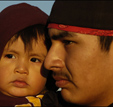 A Thunder Bay radio station has urged that the “evacuation of Kashechewan residents” now in motion in late October and early November 2005 “will be just the tip of the iceberg.”
A Thunder Bay radio station has urged that the “evacuation of Kashechewan residents” now in motion in late October and early November 2005 “will be just the tip of the iceberg.”
Jeffrey Simpson’s October 28 Globe and Mail column has similarly stressed that what has happened on the shores of James Bay is “a scandal, and politicians predictably are pointing fingers at each other … Dozens of Kashechewans are scattered throughout Northern Ontario, and many exist all across Canada … Obviously, there can be no excuse for the tainted water – a problem known about but left unattended for too long … But there is a much deeper, more painful, question about the Kashechewans of Canada, even assuming safe drinking water, adequate housing, and better schools: namely, what kind of future can there be?”
 In theory, aboriginal policy is an area in which Paul Martin’s present Liberal minority government in Ottawa has been making solid efforts to grab various bulls by various horns, in fresh and more constructive ways. But Ontario Premier Dalton McGuinty’s complaint that, down on the ground in the real world, the federal government was “asleep at the switch” on Kashechewan paints a harsher picture, which still finally seems more credible in practice.
In theory, aboriginal policy is an area in which Paul Martin’s present Liberal minority government in Ottawa has been making solid efforts to grab various bulls by various horns, in fresh and more constructive ways. But Ontario Premier Dalton McGuinty’s complaint that, down on the ground in the real world, the federal government was “asleep at the switch” on Kashechewan paints a harsher picture, which still finally seems more credible in practice.
In the end all levels of government and no doubt all political parties have a lot to answer for on aboriginal policy in Canada today. So no doubt do all the permutations and combinations of the present aboriginal leadership. And in the very end so do all we mere citizens of the Canadian free and democratic society in the early 21st century, non-aboriginal and aboriginal alike.
 Somewhere in the midst of whatever new Ottawa firestorms Justice Gomery’s November 1 report on the sponsorship scandal may or may not lead to, we all ought to take the Kashechewan calamity for the wake-up call some modern Canadian Great Spirit probably means it to be. (And “Canada” itself is, in its origins, an aboriginal word.) Something much more sensible needs to be done about aboriginal policy in the home and native land.
Somewhere in the midst of whatever new Ottawa firestorms Justice Gomery’s November 1 report on the sponsorship scandal may or may not lead to, we all ought to take the Kashechewan calamity for the wake-up call some modern Canadian Great Spirit probably means it to be. (And “Canada” itself is, in its origins, an aboriginal word.) Something much more sensible needs to be done about aboriginal policy in the home and native land.
Jeffrey Simpson no doubt makes a crucial point when he urges that the “royal commission on aboriginal affairs, established by the Mulroney government” in the 1980s, almost insanely proposed turning “the Kashechewans of Canada” into fantastically unrealistic “dream palaces,” too much on the model of the late 20th century sovereigntist movement in Quebec.
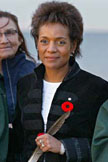 Yet the past few days have also brought news of Governor General Michaelle Jean’s visit to France, along with and in honour of Canadian aboriginal veterans of the Second World War. Here as elsewhere, the simplest truth is that the aboriginal peoples of Canada remain the first modern Canadians. What is going on now in the James Bay coastal communities began with the arrival of the Hudson’s Bay Company and the Indian-European fur trade in the late 17th century.
Yet the past few days have also brought news of Governor General Michaelle Jean’s visit to France, along with and in honour of Canadian aboriginal veterans of the Second World War. Here as elsewhere, the simplest truth is that the aboriginal peoples of Canada remain the first modern Canadians. What is going on now in the James Bay coastal communities began with the arrival of the Hudson’s Bay Company and the Indian-European fur trade in the late 17th century.
Or as the fine and still inspiring historian of The Fur Trade in Canada said 75 years ago: “We have not yet realized that the Indian and his culture were fundamental to the growth of Canadian institutions.” Acknowledging this at last may be some kind of useful first step in the fall of 2005?

